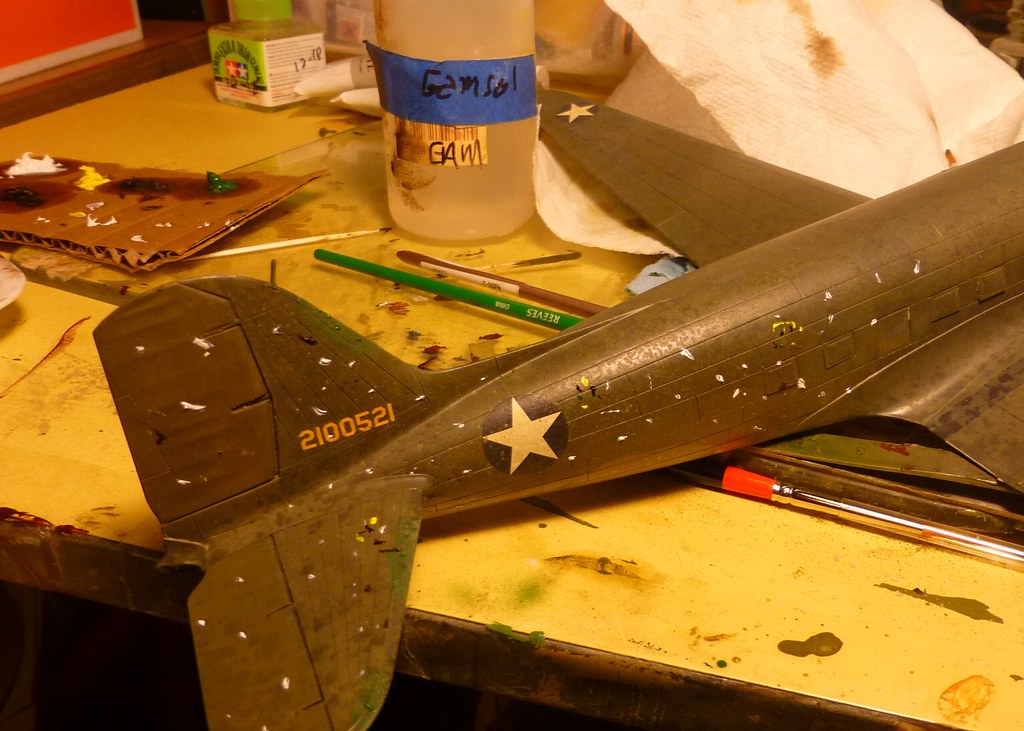Getting well into the weathering.
The first step was to do salt fading. Salt is often used for chipping (it's very good for some types of chipping - the hairspray stuff has made people forget it). It's better for fading. It's simple enough: you spray water on the model and then hit it with a good dose of salt (I use kosher and normal).
 salted by Eric Bergerud, on Flickr
salted by Eric Bergerud, on Flickr
When the salt dries, you airspray a very light coat of a grimy color. I did it twice - covered first with a grayish tan - covered second with a grayish brown. The salt makes sure that the filter doesn't hit the whole surface. In addition you get a kind of salty signature on the paint. Here's a detail of the salted C47 (BTW, for some reason the yellow color shift is very muted - you can the color of the plane pretty well in this pic: ditto for the salted plane above):
 saltdet by Eric Bergerud, on Flickr
saltdet by Eric Bergerud, on Flickr
Here's the bird fully salted and rinsed (and the yellow shift back):
 saltfade by Eric Bergerud, on Flickr
saltfade by Eric Bergerud, on Flickr
The second step is to put on an oil paint dot filter. This also fades the plane, but it also mutes some of the salted effects, and hopefully gives the finish an extra dimension. The trick to dot fading is not to over apply the oils. I have followed Doog's tip and apply oil with a toothpick. Most of the dots are Windsor Newton Transparent White - the perfect fading paint. There a little clusters of yellow/black/burnt umber. This creates a kind of olive drab. For this I use Gamblin "Fast Matte" oils and Wilder modeling oils - both dry quickly and dry matte. My solvent of choice is Gamblin's Gamsol, the most benign white spirit in the universe - you can barely smell it. It also leaves nearly zero marking when dry. If I didn't have it I'd use artist white spirit (companies like AK sell a good version) - turpentine or turpenoid are not a good choice unless you want the plastic marred. Here are the dots applied:
 oildot by Eric Bergerud, on Flickr
oildot by Eric Bergerud, on Flickr
Here's a detail pic: the left side of the wing has been filtered, the right has not - I think the difference is quite notable:
 oildet2 by Eric Bergerud, on Flickr
oildet2 by Eric Bergerud, on Flickr
Here's the C47 after the dot filter has been applied and worked in:
 postoils by Eric Bergerud, on Flickr
postoils by Eric Bergerud, on Flickr
Compare to the fully salted plane and you can see how the oils mute - but don't elminate - the salt fading. Indeed, both fading steps, when applied over the black basing, gives a grime effect to the entire plane. That's completely appropriate for a New Guinea C-47. The place was beastly hot, and it rained like crazy basically every day. In a climate like that you'll get mud turn to dust in about an hour, and there were no hangars in New Guinea. So it would be hot/sunny - hot/rainy/muddy - hot/dust day in and day out: Nothing was clean in New Guinea - including the aircrew. Place was a hardship post. My father was there for a year and a half and had no desire to visit his wartime station later in life.
 saltfade by Eric Bergerud, on Flickr
saltfade by Eric Bergerud, on Flickr
We'll let the model dry overnight - the fast drying oils applied in such small quantity will be fully ready. Then it will get a satin or gloss varnish and then out comes the Iwata Com.Art for panel lines and fluid stains. We'll also dirty up the bottom (I don't fade it because it wouldn't get the sun. But it would get the dirt.) Then we finish construction and hope the clear parts have come through okay. At the end I may even apply a lot dusting of pigments - we'll see.
Eric